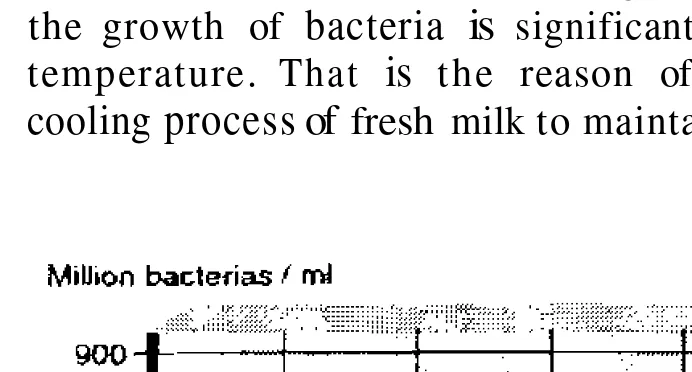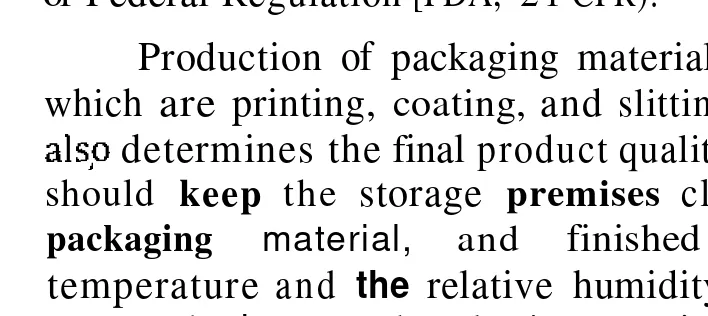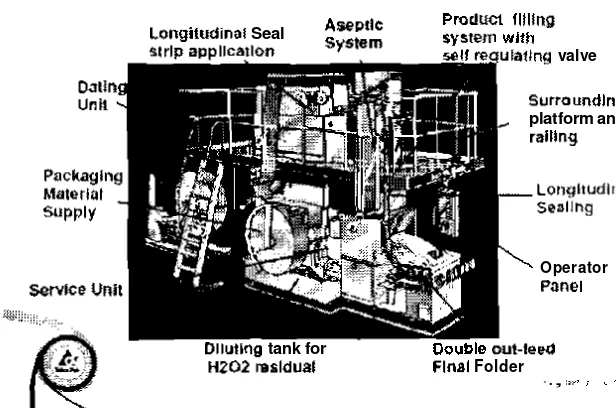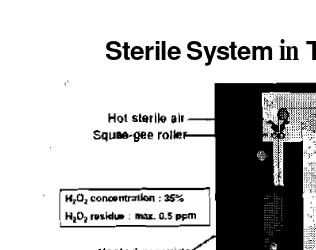and
FOOD SAFETY ISSUES
IN
FOOD PACKAGING
ASEPTIC TECHNOLOGY
APPROACH*
Hari Yanto Tekno
Tetra Pak Indonesia
ABSTRACT
Companies involved in processing, marketing and distributing food products are fully aware of the growing pressure on assuring food safety
and quality. UHT-treated and aseptically packaged products have become
popular from the viewpoint of food safety and health. Aseptic processing a n d packaging allows sensitive liquid foods to stay safe and fresh a n d protects the natural flavour and nutritional content of products.
giving consumers more quality and better taste. Since the cartons be stored un-chilled for months, consumers will benefit from improved food safety due to less spoilage a n d waste
The quality of raw (packaging) material, the U H T sterilization equipment,
the aseptic packaging system, their process controls and quality system play important roles to determine food safety, quality and conformance of the
finished products.
As the world's leading food processing and packaging solutions company, Tetra Pak is committed to making food safe a n d available, And
our commitment extends far beyond protecting the contents in a package.
also includes support for our customers' businesses, a
reduce our environmental impact, and s h a p e a better for all stakeholders from our employees, to our suppliers and communities which we operate.
ASEPTIC TECHNOLOGY A N D
ULTRA
HIGH TEMPERATURE(UHT)
SYSTEM
are four fundamental blocks of aseptic technology. First is
commercially sterile food that should be transferred aseptically into
This manuscript is prepared by the seminar committee based on the recorded
presentation o f M r . Yuwono.
t h e sterile surrounding a n d meet with sterilized packaging material so that we can have a result of aseptic finished product. As we know, there several causes of food spoilage, which are microorganisms, oxygen or gases, light, moisture, a n d odors. For example, in a
milk product, as we can see in Figure in the same period of time, the growth of bacteria is significantly different depending on the temperature. That is the reason of immediate pasteurization or cooling process of fresh milk to maintain the growth of bacteria.
8 24 28 Hours
Figure The amount of bacteria increases with milk temperature
One of most effective ways to reduce the load of bacteria i s
heat treatment, pasteurization. However, we need a sterile
product, not just a pasteurized one, in aseptic technology. In a sterile condition, a product should be free from all microorganisms. But, absolute sterility is not possible because of the logarithmic heat treatment reduction of bacteria. Therefore, the process is called commercial sterility. The commercially sterile product must be free from microorganisms and toxins harmful to the health of consumers, free from any microorganisms that can liable to proliferate during
storage and able to be kept without deterioration, also stable and
Seminar Issues Challenges
To have a good product, we have to start from raw material because raw material quality is the first condition that determines the final product quality. It is impossible to produce a high
product from poor quality raw materials, b u t it is possible to produce a poor quality product high quality raw materials. Besides that, intermediate product quality is also important. So t h a t
pre-processing should also in control, mixing, blending,
aeration, separation, sampling analysis, standardization, homogenization, and pasteurization.
In FDA regulation it is stated that UHT is achieved by involving a continuous flow of heat a t a high temperature for a short period of time (not less than in combination with a suitable holding time) so that there are no viable microorganisms or spores capable of growing in the treated product when kept in an aseptic
closed container at ambient temperature. Also, the products should
remain microbiologically stable after incubating
for
days a tor 7 days at in closed containers or after any other method demonstrating that the appropriate heat treatment h a s been applied.
Figure 2. Direct indirect
UHT,
pasteurization, and conventional sterilization systemThere are two available UHT systems, which arc indirect
systems and direct systems. Indirect systems usually plate heat
exchangers which is cheaper comparing to tubular heat exchangers,
tubular heat exchangers which is more effective for product with
particles, and scraped heat exchangers which is used for quite thick product. Comparing to indirect systems, direct system can produce
higher quality of product because it h a s a less effect to product's nutrition. There are two systems, which are steam injection and
steam infusion. Figure 2 shows the difference between direct UHT, indirect
UHT,
pasteurization, and conventional sterilization system.Basically, we can kill all kind of microorganisms by system, growth
of
pathogenic bacteria,no
spore germination, no public healthrisk, a n d can be sterilized by pasteurization for
30 seconds. Meanwhile, low acid product is mare sensitive and can be
commercial sterilized by sterilization
or
UHT
treatmentfor 2-4 seconds. The examples of low and high acid beverage processing can be seen in, respectively, Figure 3 a n d Figure
54 p l e n a r y
of Seminar Issues Safety
Figure 3. Technology of UHT milk
Figure 4. A still
drink
processing lineApproach Food
ASEPTIC PACKAGING SYSTEM
Aseptic packaging system i s a packaging process by which
microorganisms are prevented from entering into t h e package during filling process or after packaging process. This definition applies independently of the packed product, so aseptic packaging is possible whether the product is sterile or not.
Aseptic Packaging Material
Tetra Pak packaging material consist of 6 layers. As seen in Fig.
the first layer, from the outside, is polyethylene followed by paper,
polyethylene, aluminium foil, polyethylene and polyethylene. Each
that we used in Tetra Pak packaging material is compliance with European Framework Regulation and United States Law Code of Federal Regulation [FDA, 2 1 CFR).
Production of packaging material consists of 3 step processes which are printing, coating, and slitting. Packaging material quality determines the final product quality. To maintain the quality, we should keep the storage premises clean and store raw material,
packaging material, and finished product The temperature and the relative humidity should be, respectively,
Seminar Current and in Food
types of seal. which are transversal seal and longitudinal seal. LS-strip is applied for covering t h e part of sealing to the liquid product
surface of packaging material, simple filling system that gives high hygiene, totally packages for high product quality a n d good distribution, and head space possibility using inert gas injection that
enable shaking, better pouring, and new volume creation product. Overall, the benefits of aseptic products packed in Tetra Pak packages are no need chilled storage and distribution, long shelf-life without
any preservatives, high quality products with 'gentle' U H T heat treatment, convenience, and practical.
Food
Sterile System
in
TP
Filling Machines
Figure 7. Sterile system in Tetra Pak filling machines
Quality Parameters
Hydrogen Peroxide
Hydrogen peroxide is used to kill bacteria in sterilization of the
packaging material and filler. The qualification is food grade, aseptic
grade, and packaging grade.
The concentration
of the solution is50% with maximum residue 0,5 ppm on the package.
Sterility
Sterility has to be maintained during the entire length of t h e
intended production run. It is important to avoid recontamination of product and packaging material. Pressure in aseptic chamber and
sufficient temperature and concentration are also needed.
Sealing supervision to ensure the production of tight packages is also
part of the parameter.
Product Evaluation
The procedure of quality control consists of sampling and
evaluation. There
are
two typesof
sampling, which are random (timebased) and aimed. The evaluation includes pH measurement, sensory evaluation, integrity, and microbiological testing. Package
integrity
is
quite difficult because the checking procedures are very so the methods usually are careful visual examination, dye resting, conductivity measurement, dissolving of transversal seals, and tear down procedures.There are four important parameters (four Ts) to control cleaning in place, which are temperature, time, turbulence (flow), a n d titration (concentration). The efficiency of mechanical or manual cleaning mainly depends on the mechanical treatment. Therefore, appropriate tools must be available. The verification of cleaning
result consists
of
visual check, microbiological test, swab test, andATP luminescence test (adenosine triphosphate bioluminescence).
Records, and Documentation
Finished product storage applies FO principle, positive release system, proper storage control, and suitable floori a n d proper drainage. Meanwhile, record and documentation are essential for quick and efficient dealing with process a n d
troubleshooting.





